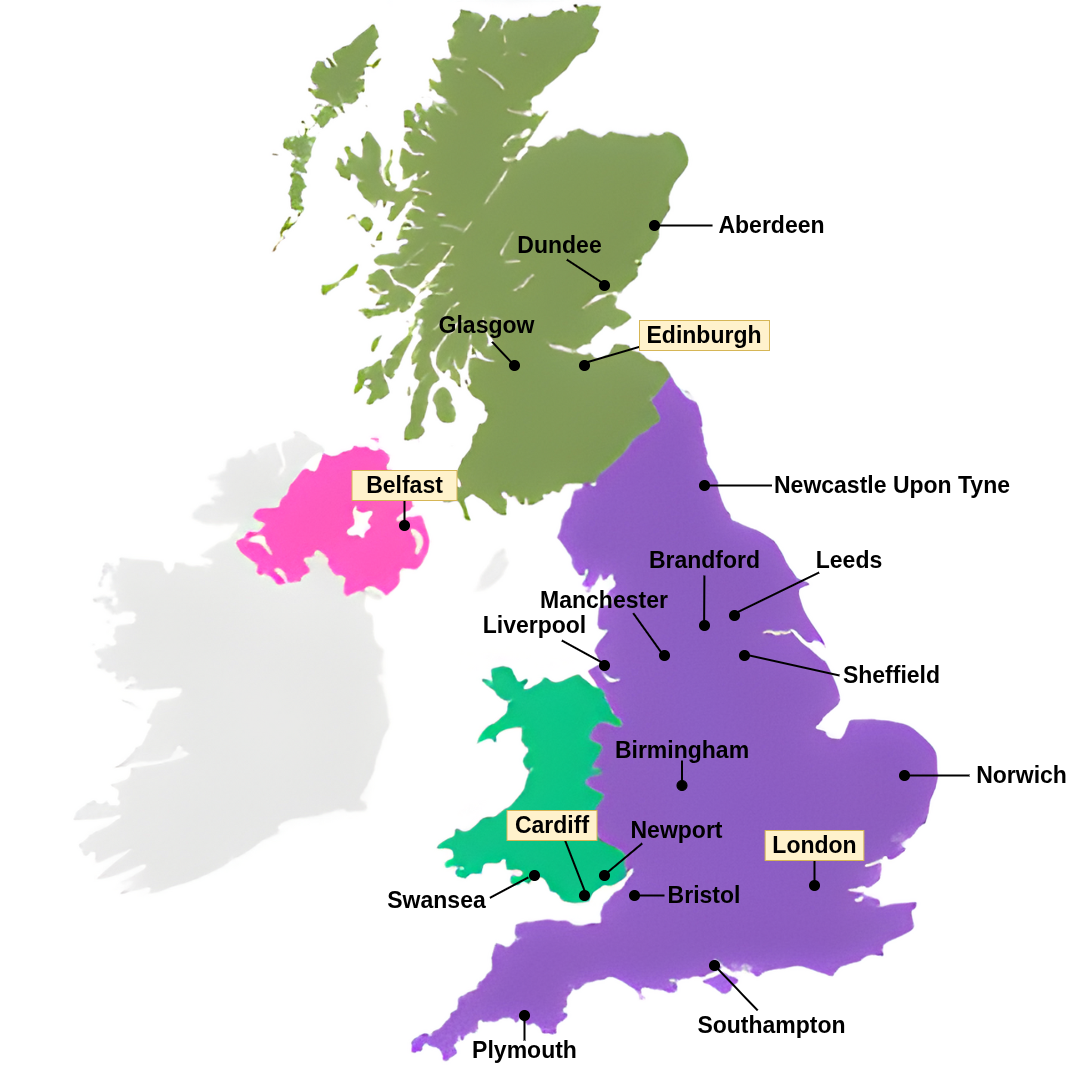The UK Today
Modern UK society, covering its diversity, geography, language, population, equality, and cultural identity.
The United Kingdom (UK) today is a very diverse country, both ethnically and religiously. After the Second World War, immigration increased, and now about 1 in 10 people has a parent or grandparent born outside the UK.
The UK remains a multinational and multiracial country with a rich, varied culture. This section explores its nations, important places, traditions, customs, and popular activities.
The Nations of the UK
The UK lies in the north-west of Europe. The longest mainland distance runs from John O’Groats (north coast of Scotland) to Land’s End (south-west of England) — about 870 miles (1,400 km).
Most people live in towns and cities, but much of the land is still countryside. Many enjoy walking, camping, and fishing there during holidays.
The Cities of the UK
The UK has many vibrant cities, each with its own unique character and attractions. Some of the most notable cities include:
- London: The capital city, known for its history, culture, and finance.
- Edinburgh: The capital of Scotland, famous for its historic and cultural attractions.
- Cardiff: The capital of Wales, known for its vibrant arts scene.
- Belfast: The capital of Northern Ireland, with a rich industrial history.

UK Currency
The UK’s currency is the pound sterling (£). There are 100 pence in one pound.
Coins: 1p, 2p, 5p, 10p, 20p, 50p, £1, and £2
Notes: £5, £10, £20, and £50
Scotland and Northern Ireland issue their own banknotes, which are valid across the UK, though shops are not legally required to accept them.
Languages and Dialects
Language varies across the UK. English is spoken everywhere but has many accents and dialects.
In Wales, many people speak Welsh, a completely different language from English. It is taught in schools and universities.
In Scotland, some areas of the Highlands and Islands speak Gaelic. In Northern Ireland, some people speak Irish Gaelic.
Population
The UK’s population has changed greatly over time. Recent growth is faster, mainly due to migration and longer life expectancy.
| Year | Population |
|---|---|
| 1600 | Just over 4 million |
| 1700 | 5 million |
| 1801 | 8 million |
| 1851 | 20 million |
| 1901 | 40 million |
| 1951 | 50 million |
| 1998 | 57 million |
| 2005 | Just under 60 million |
| 2010 | Just over 62 million |
| 2017 | Just over 66 million |
Population is not evenly spread:
- England: about 84%
- Scotland: just over 8%
- Wales: around 5%
- Northern Ireland: less than 3%
{
"type": "pie",
"data": {
"labels": [
"England (84%)",
"Scotland (8%)",
"Wales (5%)",
"Northern Ireland (3%)"
],
"datasets": [
{
"data": [84, 8, 5, 3],
"backgroundColor": [
"#8c61c5",
"#839c58",
"#0bc586",
"#ff5dbf"
],
"borderWidth": 1
}
]
},
"options": {
"responsive": true,
"maintainAspectRatio": false,
"plugins": {
"legend": {
"position": "bottom"
},
"title": {
"display": true,
"text": "Population Distribution in the UK"
}
},
"layout": {
"padding": 10
}
}
}
An Ageing Population
People in the UK are living longer than ever thanks to better living standards and health care. There are now record numbers of people aged 85 and over, which increases the cost of pensions and health care.
Ethnic Diversity
The UK is ethnically diverse, especially in big cities like London. People come from many different ethnic backgrounds.
Most describe themselves as white (including those of European, Australian, Canadian, New Zealand, and American descent). Other large groups include people of Asian, black, and mixed heritage.
An Equal Society
In the UK, men and women have equal rights. It is illegal to discriminate based on gender or marital status. Both can work, own property, marry, divorce, and share responsibility for children.
Today, women make up about half the workforce. Girls often leave school with better qualifications than boys, and more women attend university.
Women now work in all sectors, including senior roles in jobs once dominated by men. Meanwhile, men now work in a wider range of jobs too.
It is no longer expected that women stay at home. Many continue working after having children, and both partners often share childcare and household chores.
Key Points
- The UK is now a diverse, multicultural, and multinational country.
- It is located in the north-west of Europe.
- The longest mainland distance is from John O’Groats to Land’s End (870 miles).
- People live mostly in towns and cities, but the countryside remains popular for leisure.
- The UK’s currency is the pound sterling (£), divided into 100 pence.
- Scotland and Northern Ireland have their own banknotes.
- The UK has several languages: English, Welsh, Scottish Gaelic, and Irish Gaelic.
- The population has grown from 4 million (1600) to over 66 million (2017).
- Growth is due to migration and longer life expectancy.
- The population is unevenly distributed across England, Scotland, Wales, and Northern Ireland.
- People are living longer, increasing pension and healthcare costs.
- The UK is ethnically diverse, with many groups including white, Asian, black, and mixed backgrounds.
- The UK supports gender equality and bans discrimination.
- Women work in all sectors and hold senior roles.
- Both men and women now share home and childcare responsibilities.